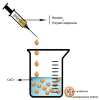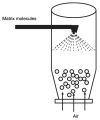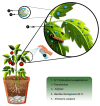Encapsulation in Alginates Hydrogels and Controlled Release: An Overview
- PMID: 38893391
- PMCID: PMC11173704
- DOI: 10.3390/molecules29112515
Encapsulation in Alginates Hydrogels and Controlled Release: An Overview
Abstract
This review aims to gather the current state of the art on the encapsulation methods using alginate as the main polymeric material in order to produce hydrogels ranging from the microscopic to macroscopic sizes. The use of alginates as an encapsulation material is of growing interest, as it is fully bio-based, bio-compatible and bio-degradable. The field of application of alginate encapsulation is also extremely broad, and there is no doubt it will become even broader in the near future considering the societal demand for sustainable materials in technological applications. In this review, alginate's main properties and gelification mechanisms, as well as some factors influencing this mechanism, such as the nature of the reticulation cations, are first investigated. Then, the capacity of alginate gels to release matter in a controlled way, from small molecules to micrometric compounds, is reported and discussed. The existing techniques used to produce alginates beads, from the laboratory scale to the industrial one, are further described, with a consideration of the pros and cons with each techniques. Finally, two examples of applications of alginate materials are highlighted as representative case studies.
Keywords: alginates; controlled release; encapsulation; hydrogels.
Conflict of interest statement
The authors declare no conflicts of interest.
Figures














Similar articles
-
Characterizing the encapsulation and release of lentivectors and adeno-associated vectors from degradable alginate hydrogels.Biomater Sci. 2019 Jan 29;7(2):645-656. doi: 10.1039/c8bm01218k. Biomater Sci. 2019. PMID: 30534722
-
State of Innovation in Alginate-Based Materials.Mar Drugs. 2023 Jun 8;21(6):353. doi: 10.3390/md21060353. Mar Drugs. 2023. PMID: 37367678 Free PMC article. Review.
-
Encapsulation of thyme (Thymus serpyllum L.) aqueous extract in calcium alginate beads.J Sci Food Agric. 2012 Feb;92(3):685-96. doi: 10.1002/jsfa.4632. Epub 2011 Sep 23. J Sci Food Agric. 2012. PMID: 21953367
-
Alginate-based hydrogels for cancer therapy and research.Int J Biol Macromol. 2021 Feb 15;170:424-436. doi: 10.1016/j.ijbiomac.2020.12.161. Epub 2020 Dec 28. Int J Biol Macromol. 2021. PMID: 33383080 Review.
-
Alginate Hydrogels with Tuneable Properties.Adv Biochem Eng Biotechnol. 2021;178:37-61. doi: 10.1007/10_2020_161. Adv Biochem Eng Biotechnol. 2021. PMID: 33547500
Cited by
-
Hyaluronic Acid-Coated Melt Electrowritten Scaffolds Promote Myoblast Attachment, Alignment, and Differentiation.bioRxiv [Preprint]. 2025 Mar 10:2025.03.06.641880. doi: 10.1101/2025.03.06.641880. bioRxiv. 2025. PMID: 40161586 Free PMC article. Preprint.
-
Applications of Natural Polymers in the Grapevine Industry: Plant Protection and Value-Added Utilization of Waste.Polymers (Basel). 2024 Dec 25;17(1):18. doi: 10.3390/polym17010018. Polymers (Basel). 2024. PMID: 39795420 Free PMC article. Review.
-
Lithium Coupled with C6-Carboxyl Improves the Efficacy of Oligoguluronate in DSS-Induced Ulcerative Colitis in C57BL/6J Mice.Mar Drugs. 2024 Dec 21;22(12):573. doi: 10.3390/md22120573. Mar Drugs. 2024. PMID: 39728147 Free PMC article.
-
Microencapsulation of antioxidant phenolics from tamarind seed peels using chia gum and maltodextrin.Sci Rep. 2025 Feb 25;15(1):6720. doi: 10.1038/s41598-025-89792-6. Sci Rep. 2025. PMID: 40000724 Free PMC article.
References
-
- Günter E.A., Popeyko O.V., Belozerov V.S., Martinson E.A., Litvinets S.G. Physicochemical and swelling properties of composite gel microparticles based on alginate and callus cultures pectins with low and high degrees of methylesterification. Int. J. Biol. Macromol. 2020;164:863–870. doi: 10.1016/j.ijbiomac.2020.07.189. - DOI - PubMed
-
- Donati I., Paoletti S. Material Properties of Alginates. In: Rehm B.H.A., editor. Alginates: Biology and Applications. Springer; Berlin/Heidelberg, Germany: 2009. pp. 1–53. Microbiology Monographs. - DOI
-
- Bennacef C., Desobry-Banon S., Probst L., Desobry S. Advances on alginate use for spherification to encapsulate biomolecules. Food Hydrocoll. 2021;118:106782. doi: 10.1016/j.foodhyd.2021.106782. - DOI
Publication types
LinkOut - more resources
Full Text Sources
Miscellaneous

